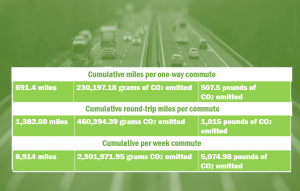One Way COVID-19 is Changing Our Carbon Footprint
By Greg Williams, Senior Energy Advisor
President Calvin Coolidge once said “After all, the chief business of the American people is business. They are profoundly concerned with producing, buying, selling, investing and prospering in the world.” As COVID-19 sweeps across the globe and our country, it is having all types of unintended consequences across our nation. It’s definitely going to change our country culturally, socially, politically but also economically. Because of this quiet and deadly killer, economic activity in this country and around the globe has upended our economy, putting millions out of work. Our interstates and highways are quiet, our schools, universities and business sit empty and our people quarantined in their homes and the entertainment and our nation’s hospitality industry has been severely restricted. Since this public health crisis is forcing millions of Americans to work from home, I began to wonder how all this “economic inactivity” was impacting our environment.
As a result, I decided to figure out what my colleagues and my carbon footprint was in terms of our roundtrip daily and weekly commute from our respective homes across the state to Baltimore, where our office is located. From a point of reference, according to the US Energy Administration, it estimates that in 2017, the United States emitted 5.1 billion metric tons of energy-related carbon dioxide, while the global emissions of energy-related carbon dioxide totaled 32.5 billion metric tons. This is how I did it and you can figure out the carbon footprint for your family or workplace as well. For more information on air trends and air quality in our country trends, please visit the Environmental Protection Agency (EPA) National Air Quality Summary.
First, I asked each of my colleagues to tell me the year, make and model of the respective vehicle they use to commute back and forth to work and how long their respective commutes were each day. Second, I went to the EPA’s Fuel Economy website to figure out the average combined city / highway mileage per gallon for each vehicle per round trip. According to the EPA, every gallon of gas burned contains 8,887 grams of CO2. Third, I took the miles per trip for each vehicle and divided it by gallons burned per trip and doubled it for each round trip. Once I figured out the total grams of CO2 emitted per trip/per round trip, I figured out the CO2 emissions of each of the vehicles at my workplace.
I was astounded by the amount of carbon emissions we, at the Maryland Energy Adminstration (MEA) are not putting into the environment during this time. MEA is a smaller state agency, with only 40 team members. Consider all the employees in Maryland, their vehicles and the miles not being driven each day and the benefits to our enviroment become very clear.
One unintended outcome of COVID-19 is we reassess how we conduct business in America. Given the advent of technology in today’s society, do we really need to spend time away from our families, the countless hours in our vehicles, and the infinite miles traveled to and from our places of work on an annual basis? Is the “new” business of America going to be teleworking from our respective homes and no longer be conducted from centralized office parks and downtown buildings? Learning on-line? Enjoying restaurant quality food from our homes and watching movies from the comfort of our living rooms? Time will only tell but our environment will appreciate it when this happens.
For more energy insights, tips and information on energy programs available to Marylanders, visit the Maryland Energy Administration online at Energy.Maryland.gov.



 1-888-373-7888
1-888-373-7888 233733
233733